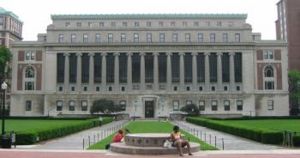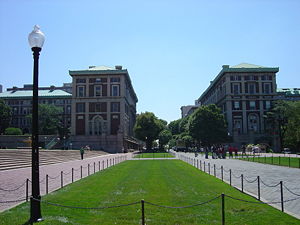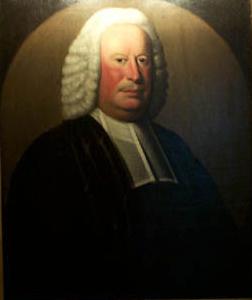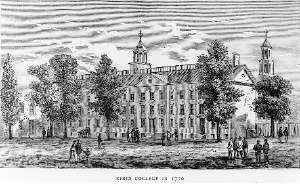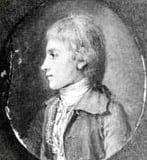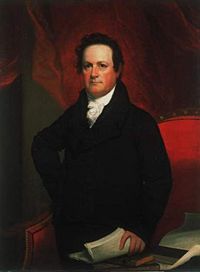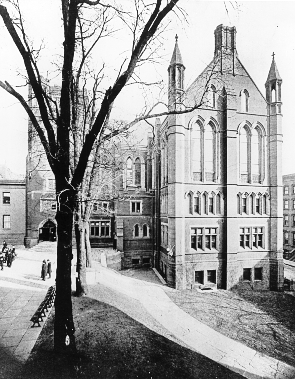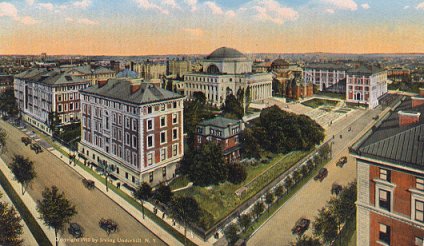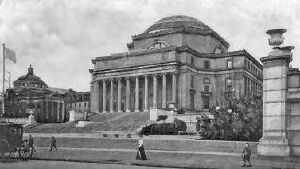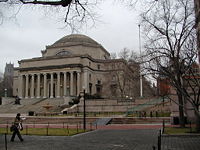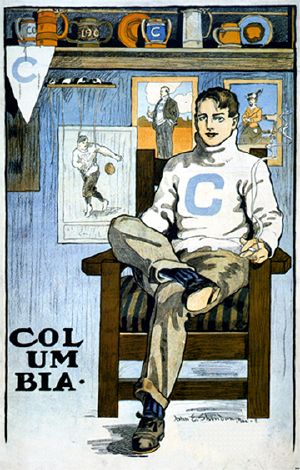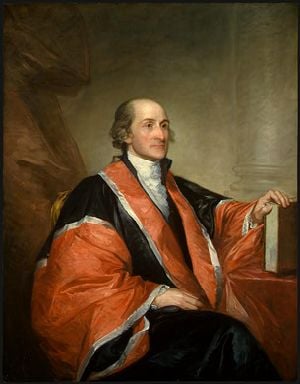Columbia University
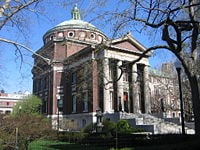
| |
| Motto | In lumine Tuo videbimus lumen (In Thy light shall we see the light) (a paraphrase of Psalm 35:10) |
|---|---|
| Established | 1754 |
| Type | Private |
| Location | New York, New York USA |
| Website | www.columbia.edu |
Columbia University is a private university whose main campus lies in the Morningside Heights neighborhood of the Borough of Manhattan in New York City. It is one of the eight Ivy League universities and among the most prestigious institutions of higher education in the world. The institution was established by the Church of England, receiving a royal charter in 1754 as King's College from George II of Great Britain, and is one of the oldest institutions of higher education in the United States. During the early years of its history, Alexander Hamilton, John Jay, Gouverneur Morris, and Robert Livingston studied at King's College.
The university is legally known as Columbia University in the City of New York and is incorporated as The Trustees of Columbia University in the City of New York. Its undergraduate schools are: Columbia College (CC), the Fu Foundation School of Engineering and Applied Science (SEAS), and, for students who want to begin or resume their education after years of interruption, the School of General Studies (GS).
The university is also affiliated with: Barnard College (BC), an undergraduate liberal arts college for women and one of the Seven Sisters; the Jewish Theological Seminary; and the Union Theological Seminary, all located nearby in Morningside Heights. A joint undergraduate program is available through the Juilliard School. the University has produced leaders in all walks of life. It has maintained high standards of scholarship, often challenging traditional assumptions and helping to establish new paradigms, distancing itself over the passage of time from the establishment roots of the original College.
Campus
Morningside Heights
Most of Columbia's graduate and undergraduate studies are conducted in Morningside Heights on Seth Low's late-nineteenth century vision of a university campus where all disciplines could be taught in one location. The campus was designed along Beaux Arts principles by acclaimed architects McKim, Mead, and White and is considered one of their best works. Its original open, urban feel has been somewhat modified by the addition of such buildings as Butler Library, which have served to almost fully enclose its interior open space.
Columbia's main campus occupies more than six city blocks, or 32 acres (132,000 m²), in Morningside Heights, a neighborhood located between the Upper West Side and Harlem sections of Manhattan that contains a number of academic institutions. The university owns over 7,000 apartments in Morningside Heights, which house faculty, graduate students, and staff. Several undergraduate dormitories (purpose-built or converted) are also located in the surrounding neighborhood.
New buildings and structures on the campus, especially those built following the Second World War, have often only been constructed after a contentious process often involving open debate and protest over the new structures.
Columbia's library system includes over nine million volumes.[1] One library of note on campus is the Avery Architectural and Fine Arts Library which is the largest library of architecture in the United States and among, if not the largest, in the world.[2] The library contains more than 400,000 volumes, of which most are non-circulating and must be read on site. One of the library's prominent undertakings is the Avery Index to Architectural Periodicals, which is one of the foremost international resources for locating citations to architecture and related topics in periodical literature. The Avery Index covers periodicals thoroughly back to the 1930s, with limited coverage dating to the nineteenth century, up to the present day.
Several buildings on the Morningside Heights campus are listed on the National Register of Historic Places. Low Memorial Library, the centerpiece of the campus, is listed for its architectural significance. Philosophy Hall is listed as the site of the invention of FM radio. Also listed is Pupin Hall, a National Historic Landmark, which houses the physics and astronomy departments, where initial experiments on the nuclear fission of uranium were conducted by Enrico Fermi. The uranium atom was split there ten days after the world's first atom-splitting in Copenhagen, Denmark.
Other campuses
Health-related schools are located at the Columbia University Medical Center, twenty acres located in the neighborhood of Washington Heights, fifty blocks uptown (north) from the main campus. Columbia also owns the 26-acre Baker Field, which includes the Lawrence A. Wien Stadium as well as facilities for field sports, outdoor track, tennis, and rowing at the northern tip of Manhattan island (in the neighborhood of Inwood). There is a third campus on the west bank of the Hudson River, the 157-acre Lamont-Doherty Earth Observatory in Palisades, New York, and another, the Nevis Laboratories in Irvington, New York. The university also operates Reid Hall in Paris.
History
Columbia is the oldest institution of higher education in the state of New York. Founded and chartered as King's College in 1754, Columbia is the sixth-oldest such institution in the United States (by date of founding; fifth by date of chartering). After the American Revolutionary War, King's College was renamed Columbia College in 1784, and in 1896 it was further renamed Columbia University. Columbia has grown over time to encompass twenty schools and affiliated institutions.
King's College: 1754-1776
Controversy surrounded the founding of the new college in New York, as it was thoroughly a Church of England institution dominated by the influence of Crown officials, such as the Archbishop of Canterbury and the Crown Secretary for Plantations and Colonies in its governing body. The fears of a Church of England episcopacy and British monarchy influence in America through King's College were confirmed by its vast wealth, far surpassing all other colonial colleges of the period.[3]
The American Revolution and the subsequent war were catastrophic for King's College. It suspended instruction in 1776 and remained so for eight years: beginning with the arrival of the Continental Army in the spring of that year and continuing with the military occupation of New York City by British troops until their departure in 1783. The college's library was looted and its sole building requisitioned for use as a military hospital, first by American and then British forces. Additionally, many of the college's alumni, primarily Loyalists, fled to Canada or Great Britain in the war's aftermath, leaving its future governance and financial status in question. Although the college had been considered a bastion of Tory sentiment, it nevertheless managed to produce many key leaders of the Revolutionary generation—individuals later instrumental in the college's revival. Among the early King's College students had been John Jay, who negotiated the Treaty of Paris between the United States and Great Britain, ending the American Revolutionary War, and who later became the first Chief Justice of the United States; Alexander Hamilton, military aide to General George Washington, author of most of the Federalist Papers, and the first Secretary of the Treasury; Gouverneur Morris, the author of the final draft of the United States Constitution; and Robert R. Livingston, a member of the five-man committee that drafted the Declaration of Independence.
Hamilton's first experience with the military came while a student during the summer of 1775, after the outbreak of fighting at Boston. Along with Nicholas Fish, Robert Troup, and a group of other students from King's, he joined a volunteer militia company called the "Hearts of Oak" and achieved the rank of Lieutenant. They adopted distinctive uniforms, complete with the words "Liberty or Death" on their hatbands, and drilled under the watchful eye of a former British officer in the graveyard of the nearby St. Paul's Chapel. In August of 1775, while under fire from the HMS Asia, the Hearts of Oak (also known as the "Corsicans") participated in a successful raid to seize cannon from Battery Park in New York City, becoming an artillery unit thereafter. Ironically in 1776, Captain Hamilton would engage in the Battle of Harlem Heights, which took place on and around the site that would later become home to his Alma Mater.
Early Columbia College: 1784-1857
Although the college had been tainted by its association with the Loyalist establishment prior to the war, the remaining alumni, including Hamilton and Jay, and especially the would-be governors of King's College, argued passionately for its reopening. Nevertheless, it was probably ultimately the fact that New York State Governor George Clinton was forced to send his nephew DeWitt Clinton to New Jesey for a college education at to Princeton University that prompted local sentiment to favor the need of a local college to retain him, and a renewed King's College, which could easily provide the necessary facilities, was the logical choice. In 1784, the school reopened as Columbia College, the romantically patriotic name meant to demonstrate its commitment to the new republic.
The nature of the reopening, however, made possible via the encouragements of Governor Clinton and the state legislature, ensured that Columbia College would be an institution as distinct as much in kind as in name. The new charter made no mention of the college's former Anglican and Episcopalian affiliations. Its governance was to be handled by a Board of Regents representing all the counties of New York State, with Governor Clinton as Chancellor. As a state asset under state control, Columbia became the basis for a statewide public education system.
As the state proved negligent in its funding of the institution, this arrangement became increasingly unsatisfactory for both. An expansion of the Regents to 20 New York City residents had placed Hamilton and Jay at the helm, and they, along with New York City Mayor James Duane, argued for privatization of the college. In 1787, a new charter was adopted for the college, which is still in use, granting power to a private board of Trustees. Samuel Johnson's son, William Samuel Johnson, became its president.
Columbia's performance flagged for the remainder of the first half of the nineteenth century. The law faculty never managed to thrive during this period, and in 1807, the medical school, hoping to arrest its decline, broke off to merge with the independent College of Physicians and Surgeons. Contention between students and faculty were highlighted by the "Riotous Commencement" of 1811, in which students violently protested the faculty's decision not to confer a degree upon John Stevenson, who had inserted objectionable words into his commencement speech. Though the college was finally able to shake its embarrassing reputation for structural shabbiness by adding several wings to College Hall and refinishing it in the more fashionable Greek Revival style, the effort failed to halt Columbia's long-term downturn and was soon overshadowed by the Gibbs Affair of 1854, in which famed chemistry professor Oliver Wolcott Gibbs was denied a professorship at the college, from which he had graduated, due to his Unitarian affiliation. The event demonstrated to many, including frustrated diarist and trustee George Templeton Strong, the narrow-mindedness of the institution. By July 1854, the Christian Examiner of Boston, in an article entitled "The Recent Difficulties at Columbia College," noted that the school was "good in classics" yet "weak in sciences" and had "very few distinguished graduates".[4]
Expansion and the move to Madison Avenue
In 1857, the College moved from Park Place to a primarily Gothic Revival campus on 49th Street and Madison Avenue, where it remained for the next fifty years. The transition to the new campus coincided with a new outlook for the college; during the commencement of that year, College President Charles King proclaimed Columbia "a university." During the last half of the nineteenth century, under the leadership of President Frederick Augustus Porter Barnard, the institution rapidly assumed the shape of a true modern university. Columbia Law School was founded in 1858, and in 1864, the Columbia University School of Mines, the country's first such institution and the precursor to today's Fu Foundation School of Engineering and Applied Science, was established. Barnard College for Women, established by the eponymous Columbia president, was established in 1889; the Columbia University College of Physicians and Surgeons came under the aegis of the University in 1891, followed by Teachers College in 1893. The Graduate Faculties in Political Science, Philosophy, and Pure Science awarded its first PhD in 1875.[4] This period also witnessed the inauguration of Columbia's participation in intercollegiate sports, with the creation of the baseball team in 1867, the organization to the football team in 1870, and the creation of a crew team by 1873. The first intercollegiate Columbia football game was a 6-3 loss to Rutgers. The Columbia Daily Spectator began publication during this period as well, in 1877.[5]
Morningside Heights
In 1896, the trustees officially authorized the use of yet another new name, Columbia University, and today the institution is officially known as "Columbia University in the City of New York." Additionally, the engineering school was renamed the "School of Mines, Engineering and Chemistry." At the same time, University president Seth Low moved the campus again from 49th Street to its present location, a more spacious (and, at the time, more rural) campus in the developing neighborhood of Morningside Heights. The site was formerly occupied by the Bloomingdale Insane Asylum. One of the asylum's buildings, the warden's cottage (later known as East Hall and Buell Hall), is still standing.
The building often depicted as emblematic of Columbia is the centerpiece of the Morningside Heights campus, Low Memorial Library. Constructed in 1895, the building is still referred to as "Low Library" although it has not functioned as a library since 1934. It houses the offices of the President and Provost, the Visitor's Center, the Trustees' Room and Columbia Security. In addition, the Columbiana Archives are located in the building. Patterned on several precursors, including the Parthenon and the Pantheon, it is surmounted by the largest all-granite dome in the United States.[6]
Under the leadership of Low's successor, Nicholas Murray Butler, Columbia rapidly became the nation's major institution for research, setting the "multiversity" model that later universities would adopt. On the Morningside Heights campus, Columbia centralized on a single campus: The College, the School of Law, the Graduate Faculties, the School of Mines (predecessor of the Engineering School), and the College of Physicians & Surgeons. Butler went on to serve as president of Columbia for over four decades and became a giant in American public life (as one-time vice presidential candidate and a Nobel Laureate). His introduction of "downtown" business practices in university administration led to innovations in internal reforms such as the centralization of academic affairs, the direct appointment of registrars, deans, provosts, and secretaries, as well as the formation of a professionalized university bureaucracy, unprecedented among American universities at the time.
In 1893, the Columbia University Press was founded in order to "promote the study of economic, historical, literary, scientific and other subjects; and to promote and encourage the publication of literary works embodying original research in such subjects." Among its publications are The Columbia Encyclopedia, first published in 1935, and The Columbia Lippincott Gazetteer of the World, first published in 1952.
In 1902, New York newspaper magnate Joseph Pulitzer donated a substantial sum to the University for the founding of a school to teach journalism. The result was the 1912 opening of the Graduate School of Journalism — the only journalism school in the Ivy League. The school is the administrator of the Pulitzer Prize and the duPont-Columbia Award in broadcast journalism.
Columbia Business School was added in the early twentieth century. During the first half of the twentieth Century, Columbia and Harvard had the largest endowments in the country.
By the late 1930s, a Columbia student could study with the likes of Jacques Barzun, Paul Lazarsfeld, Mark Van Doren, Lionel Trilling, and I. I. Rabi. The University's graduates during this time were equally accomplished—for example, two alumni of Columbia's Law School, Charles Evans Hughes and Harlan Fiske Stone (who also held the position of Law School dean), served successively as Chief Justices of the United States. Dwight Eisenhower served as Columbia's president from 1948 until he became the President of the United States in 1953, although he spent the majority of his University presidency on leave as Supreme Commander of NATO forces in Europe.
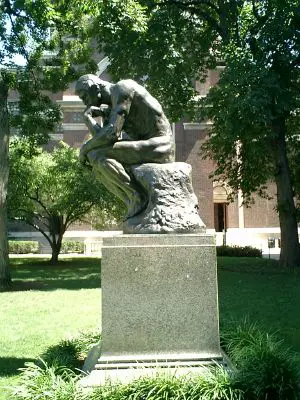
Research into the atom by faculty members John R. Dunning, I. I. Rabi, Enrico Fermi, and Polykarp Kusch placed Columbia's Physics Department in the international spotlight in the 1940s after the first nuclear pile was built to start what became the Manhattan Project.
Following the end of World War II, the School of International Affairs was founded in 1946. Focusing on developing diplomats and foreign affairs specialists, the school began by offering the Master of International Affairs. To satisfy an increasing desire for skilled public service professionals at home and abroad, the School added the Master of Public Administration degree in 1977. In 1981, the School was renamed the School of International and Public Affairs (SIPA). The School introduced an MPA in Environmental Science and environmental policy in 2001, and in 2004, SIPA inaugurated its first doctoral program — the interdisciplinary Ph.D. in Sustainable Development.
In 1997, the Columbia Engineering School was renamed the Fu Foundation School of Engineering and Applied Science in honor of Chinese businessman Z. Y. Fu, who gave Columbia $26 million. The school is now referred to as "SEAS" or simply, "the engineering school."
Student Life
Many Columbia students live on campus or near the campus in one of the Halls of Residence. The University has a wealth of student activities, ranging from competitive sports to the full range of Greek societies, drama, debate, newspaper publishing and broadcasting. A highlight of the year is the annual Varsity Show, written for and by students. The University has produced its share of baseball and football heroes, as well as such icons of entertainment as Rodgers and Hammerstein, Lorenz Hart, screenwriters Sidney Buchman and I.A.L. Diamond, critic and biographer Tim Page and musician and performing artist Art Garfunkel.
Academic reputation
In 2006, U.S. News and World Report.[7] ranked the undergraduate program at Columbia University ninth (tied with the University of Chicago and Dartmouth College) among national universities. Shanghai Jiaotong University's Institute of Higher Education ranked Columbia seventh worldwide in scientific research. The Washington Monthly rankings, meant to counterbalance the U.S. News rankings with a different methodology and intent (attempting to measure schools as an engine of service, beneficial research, and upward mobility), places Columbia at 36th overall nationally in 2006.[8]
Awards and honors
As of October 2006, 81 Columbia University affiliates have been honored with Nobel Prizes for their work in physics, chemistry, medicine, literature, peace studies, and economics.[9]
- Other awards/honors won by current faculty include
- MacArthur Foundation Award: 28[10]
- National Medal of Scienc]: 4[10]
- The National Academies: 99 (sum of 41+20+38, below)
- American Academy of Arts and Sciences: 143[10]
Alumni and attendees

Two former Presidents of the United States have attended Columbia. Six Justices of the Supreme Court of the United States and 37 Nobel Prize winners have obtained degrees from Columbia. Three United States Senators and 16 current Chief Executives of Fortune 500 companies hold Columbia degrees, as do three of the 25 wealthiest Americans.
Attendees of King's College, Columbia's predecessor, included Founding Fathers Alexander Hamilton, John Jay, Robert R. Livingston, and Gouverneur Morris. United States Supreme Court Chief Justices Harlan Fiske Stone, Charles Evans Hughes, and Associate Justice Benjamin Cardozo, as well as former United States Presidents Theodore Roosevelt and Franklin Delano Roosevelt, were all educated at the law school. Former U.S. President Dwight D. Eisenhower served as President of the University. Other significant figures in American history to attend the university were John L. O'Sullivan, the journalist who coined the phrase "manifest destiny," Alfred Thayer Mahan, the geostrategist who wrote on the significance of sea power, and progressive intellectual Randolph Bourne. Former Secretary of State Alexander Haig studied at Columbia Business School between 1954 and 1955. Wellington Koo, a Chinese diplomat who argued passionately against Japanese and Western imperialism in Asia at the Paris Peace Conference, is a graduate, having honed his debating skills in Columbia's Philolexian Society, as is Dr. B. R. Ambedkar, founding father of India and co-author of its constitution. Local politicians have been no less represented at Columbia, including Seth Low, who served as both President of the University and Mayor of the City of New York, and New York governors Thomas Dewey, also a U.S. presidential candidate, DeWitt Clinton, who presided over the construction of the Erie Canal, Hamilton Fish, later to become United States Secretary of State, and Daniel D. Tompkins, who also served as a Vice-President of the United States.
More recent political figures educated at Columbia include current United States Senators Barack Obama of Illinois and Judd Gregg of New Hampshire, former United States Secretary of State Madeleine Albright, United Nations weapons inspector Hans Blix, former United Nations Secretary General Boutros Boutros-Ghali, conservative commentators Pat Buchanan and Norman Podhoretz, United States Supreme Court Justice Ruth Bader Ginsburg, former chairman of the United States Federal Reserve Bank Alan Greenspan, broadcast media commentator George Stephanopoulos, Senior Adviser to United States President Bill Clinton, George Pataki, Governor of New York State, and Mikhail Saakashvili, President of the country of Georgia.
Scientists Stephen Jay Gould, Robert Millikan, and Michael Pupin, cultural historian Jacques Barzun, literary critic Lionel Trilling, sociologist Immanuel Wallerstein and poet-professor Mark Van Doren, philosophers Irwin Edman and Robert Nozick, and economists Milton Friedman and Daniel C. Kurtzer all obtained degrees from Columbia.
In culture and the arts, Rodgers and Hammerstein, Lorenz Hart, screenwriters Sidney Buchman and I.A.L. Diamond, critic and biographer Tim Page and musician Art Garfunkel are all among Columbia's alumni. The poets Langston Hughes, Federico García Lorc], Joyce Kilmer and John Berryman, the writers Eudora Welty, Isaac Asimov, J. D. Salinger, Upton Sinclair, Jack Kerouac, Allen Ginsberg, Phyllis Haislip, Herman Wouk, and Paul Auster, the playwright Tony Kushner, the architects Robert A. M. Stern, Ricardo Scofidio, and Peter Eisenman, and the composer Béla Bartók also attended the university. Trappist monk, author, and humanist Thomas Merton is an alumnus as well. Urban theorist and cultural critic Jane Jacobs spent time at the School of General Studies. Educator Elisabeth Irwin received her Master of Arts there in 1923. Television talk show host Sally Jesse Raphael is also a graduate.
Baseball legends Lou Gehrig and Sandy Koufax, along with football quarterback Sid Luckman and sportscaster Roone Arledge, are alumni.
Less notable, but still worth mentioning, are the celebrities who graduated from Columbia, including the actors Brian Dennehy, Ben Stein, George Segal, Maggie Gyllenhaal, Matthew Fox, Rider Strong, and Julia Stiles. Anna Paquin, who won an Academy Award for her performance in the The Piano, also attended Columbia. Finally, the actress Famke Janssen studied writing and literature at Columbia. Director of the New York City Planning Department Amanda Burden received her masters at Columbia. Louis V. Heinz of H.J. Heinz Company, the most global United States–based food company, also completed his studies here. James Doty, the inventor of penne a la vodka, is also an alumnus. Director Spike Lee has been spotted arriving for an evening class on campus.[13]
Faculty and affiliates
Jacques Barzun, Lionel Trilling, and Mark Van Doren were legendary Columbia faculty members as well as graduates, teaching alongside such luminaries as the philosopher John Dewey, American historians Richard Hofstadter, John A. Garraty, and Charles Beard, sociologists Daniel Bell, C. Wright Mills, Robert K. Merton, and Paul Lazarsfeld, and art historian Meyer Schapiro. The history of the discipline of anthropology for practical purposes begins at Columbia with Franz Boas. Margaret Mead, a Barnard College alumna, along with Columbia graduate Ruth Benedict, continued this tradition by bringing the discipline into the spotlight. Nuclear physicists Enrico Fermi, John R. Dunning, I. I. Rabi, and Polykarp Kusch helped develop the Manhattan Project at the university, and pioneering geophysicist Maurice Ewing made great strides there toward the understanding of plate tectonics. Thomas Hunt Morgan discovered the chromosomal basis for genetic inheritance at his famous "fly room" at the university, laying the foundation for modern genetics. Philosopher Hannah Arendt was a visiting professor in the 1960s.
Architects Bernard Tschumi, Santiago Calatrava, and Frank Gehry have taught at the Columbia. The post-colonial scholar Edward Said taught at Columbia, where he spent virtually the entirety of his academic career, until his death in 2003. Former American Vice President and presidential candidate Al Gore also taught at the School of Journalism.
Celebrated faculty members include string-theory expert Brian Greene, American historian Eric Foner, Middle Eastern studies expert Richard Bulliet, New York City historian Kenneth T. Jackson, literary theorist Gayatri Chakravorty Spivak, British historian Simon Schama, art historian Rosalind Krauss, director Mira Nair, East Asian studies expert Wm. Theodore de Bary, and economists Jeffrey Sachs, Jagdish Bhagwati, Joseph Stiglitz, Edmund Phelps, Xavier Sala-i-Martin.
In the Fall Semester of 2006, playwright and former Czech president Václav Havel will assume the position of artist in residence on Columbia's campus, a position held by British playwright Peter Brook.[14]
In geography
The Columbia Glacier, one of the largest in Alaska's College Fjord, is named after the university, where it sits among other glaciers named for the Ivy League and Seven Sisters schools. Mount Columbia in the Collegiate Peaks Wilderness of Colorado also takes its name from the university and is situated among peaks named for Harvard University, Yale University, Princeton University, and Oxford.
Notes
- ↑ Columbia University Office of the Provost, FACTS 2005: Libraries. Retrieved August 20, 2007.
- ↑ Royal Institute of British Architects (R.I.B.A.).
- ↑ Robert A. McCaughey, Farewell, Aristocracy—The World Turned Upside Down. Retrieved August 19, 2007.
- ↑ 4.0 4.1 Robert McCaughey, Appendix E: Institutional Comparisons. Retrieved August 19, 2008.
- ↑ Columbia University, Columbia College Student Life Timeline. Retrieved August 20, 2007.
- ↑ Columbia Univeristy, Low Memorial Library. Retrieved August 19, 2007.
- ↑ US News and World Report, Country's Best Colleges. Retrieved August 20, 2007.
- ↑ Washington Monthly, College Rankings. Retrieved August 20, 2007.
- ↑ Columbia University, Nobel Laureates. Retrieved August 19, 2007.
- ↑ 10.0 10.1 10.2 10.3 Student Affairs, Columbia University Office of Undergraduate Admissions. Retrieved August 19, 2007.
- ↑ National Academy of Engineering, Members By Parent Institution.
- ↑ Institute of Medicine of the National Academies, Membership Directory. Retrieved August 19, 2007.
- ↑ Ivy Leak, Spike Lee. Retrieved August 19, 2007.
- ↑ Columbia University, Václav Havel, Artist in Residence at Columbia This Fall, Columbia News. Retrieved August 10, 2006.
ReferencesISBN links support NWE through referral fees
- Humphrey, David C. From King's College to Columbia, 1746-1800. New York: Columbia University Press, 1976. ISBN 9780231039420.
- McCaughey, Robert A. Stand, Columbia: A History of Columbia University in the City of New York, 1754-2004. New York: Columbia University Press, 2003. ISBN 9780231130080.
- Susi, Michael V. Columbia University and Morningside Heights. Postcard history series. Charleston, SC: Arcadia Pub, 2007. ISBN 9780738549767.
External links
All links retrieved January 7, 2024.
- Columbia University homepage
- Columbia College - undergraduate school of arts and science.
- Fu Foundation School of Engineering and Applied Science - undergraduate and graduate engineering school.
- Barnard College.
- Columbia University School of International and Public Affairs.
- Columbia School of General Studies.
- Columbia Daily Spectator - second oldest student newspaper in the nation.
- Columbia Political Union.
- Columbia University Glee Club.
- Double Discovery Center.
- The Columbia Undergraduate Science Journal.
- Columbia Law School.
| The Ivy League |
|---|
| Brown (Bears) • Columbia (Lions) • Cornell (Big Red) • Dartmouth (Big Green) • Harvard (Crimson) • Penn (Quakers) • Princeton (Tigers) • Yale (Bulldogs) |
| |||||
Credits
New World Encyclopedia writers and editors rewrote and completed the Wikipedia article in accordance with New World Encyclopedia standards. This article abides by terms of the Creative Commons CC-by-sa 3.0 License (CC-by-sa), which may be used and disseminated with proper attribution. Credit is due under the terms of this license that can reference both the New World Encyclopedia contributors and the selfless volunteer contributors of the Wikimedia Foundation. To cite this article click here for a list of acceptable citing formats.The history of earlier contributions by wikipedians is accessible to researchers here:
The history of this article since it was imported to New World Encyclopedia:
Note: Some restrictions may apply to use of individual images which are separately licensed.
